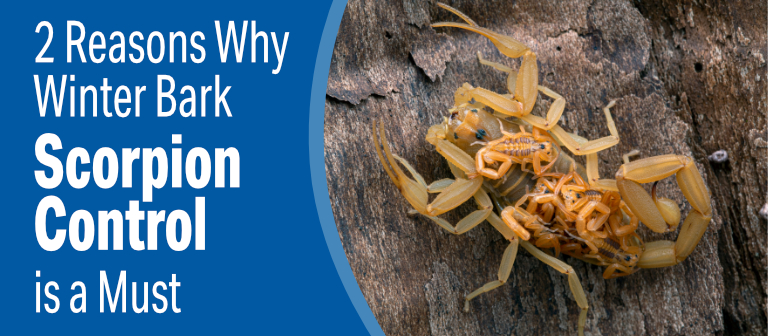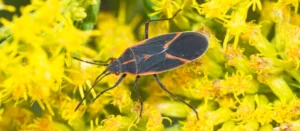$50 OFF New Residential Customers. Learn more
Two Reasons Why Winter Bark Scorpion Control Is a Must

As temperatures fall, pest activities drop in kind…including scorpion activity. With decreased activity, it’s easy to adopt an ‘out of sight, out of mind’ attitude. However, skipping bark scorpion control during winter months results in missing one of the most opportune times to treat.
Keep reading to find out some interesting facts about the Arizona bark scorpion and the two reasons why winter scorpion control is a must. If you need winter bark scorpion control in Arizona, we can help. We have offices in Gilbert and Phoenix that make it easy for us to serve the entire metro area including Peoria, Tempe, Mesa, Scottsdale, Avondale, and all the way out to Surprise.
Arizona Bark Scorpion: The Basics
At just over 3 inches, the Arizona bark scorpion is the only scorpion in the United States considered life-threatening to humans. While stings are rarely fatal, they do cause extreme pain and medical attention is advised for pets, young children, elderly, and those with chronic medical conditions.
Arizona bark scorpions are found throughout the Phoenix metropolitan area. They prefer riparian areas, but the explosive growth in the valley, and corresponding landscape and irrigation systems, have provided favorable conditions for bark scorpions to adapt to the urban environment.
Having survived months of being frozen and even showing no adverse effects after being found near ground zero of nuclear testing sites, the Arizona bark scorpion is incredibly resilient.
In addition to being resilient, and unlike most scorpions, Arizona bark scorpions are excellent climbers. Combine their climbing skills with their ability to fit into spaces as small as 1/16th of an inch, and it is easy to see why bark scorpions are often found as uninvited guests within homes.
While the Arizona bark scorpion is incredibly adaptable and resilient, proper treatment can keep them under control. Let’s jump into why proper treatment during winter months is especially important.
Reason 1: Winter Gathering
As temperatures decrease and daylight hours get shorter, scorpions gather in groups seeking safe haven in hidden places. In addition, Arizona bark scorpions enter diapause, a state of lower to no activity brought on by unfavorable environmental conditions, namely colder temperatures. They will stay in diapause until nighttime temperatures average 73°F or above.
So, during winter months, Arizona bark scorpions are gathered together in a state of minimal activity, thus increasing the effectiveness of proper scorpion treatment.
Reason 2: Mating Activity
The other reason winter treatment is a must revolves around the Arizona bark scorpions’ mating activities. Often mating in the fall, female bark scorpions have a gestation period throughout the winter months. As weather warms, the resulting litters range from 25-35 young scorpions contributing to increased activity in the spring.
Thus, proper winter scorpion treatment, during the gestation period, minimizes the next generation of bark scorpions before they become a problem.
Recap
As mentioned previously, colder winter months result in little to no scorpion activity, but it is the opportune time to apply the proper bark scorpion treatment because…
- Scorpions are gathered together in a lethargic state (diapause) compounding the effects of proper treatment.
- Addressing bark scorpions during the gestation period reduces the next wave of scorpions before they are born.
Why Blue Sky
Being an Arizona owned company, with a technical management team with over 100 years of Arizona pest experience, and technicians with at least 100 hours of training, we have the know how to keep your Arizona home scorpion and pest free. As always, we are happy to tailor a customized plan to fit your unique scorpion and pest needs.
Related Posts

Killer Bees in Arizona? Understanding Africanized Bees and How to Coexist Safely
You’ve likely heard the term “killer bees” used to describe Africanized bees in Arizona, but did you know this nickname…

Red & Black Intruders: Meet Arizona’s Boxelder Bugs
Boxelder Bugs in Arizona If you’ve ever stepped outside and spotted a cluster of black-and-red bugs crawling on your porch…

Jumping Spiders in Arizona: Harmless or Hazardous?
Jumping spiders in Arizona might be small, but they can sure give you a big surprise when they suddenly appear…